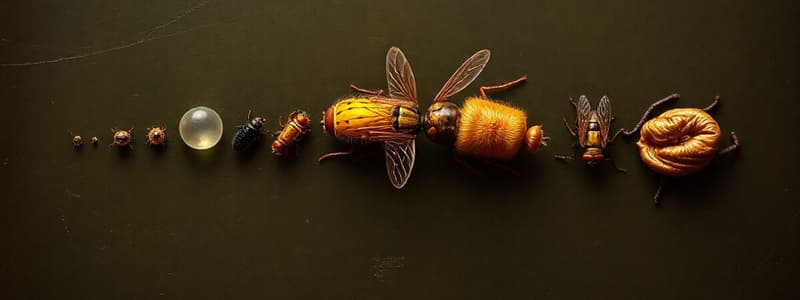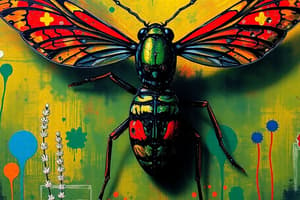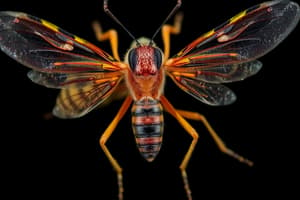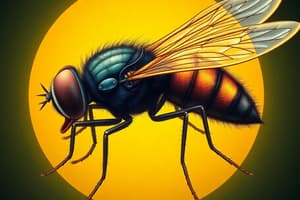Podcast
Questions and Answers
What role do insects play in determining the time of death (TOD) in forensic investigations?
What role do insects play in determining the time of death (TOD) in forensic investigations?
Insects help estimate the time of death by providing evidence about the decomposition stages and environmental conditions.
Which insect is typically the first to arrive at a body after death, and what is its significance in forensic entomology?
Which insect is typically the first to arrive at a body after death, and what is its significance in forensic entomology?
Blowflies are the first insects to arrive, and they are significant because their life cycle stages can indicate the time of death.
List the six stages of the blowfly life cycle important for forensic entomology.
List the six stages of the blowfly life cycle important for forensic entomology.
The six stages are Eggs, Instar I, Instar II, Instar III, Pupa, and Adult Blowfly.
How do forensic entomologists collect insect evidence from a crime scene?
How do forensic entomologists collect insect evidence from a crime scene?
Explain how the life cycle of insects can provide clues to the stage of decomposition.
Explain how the life cycle of insects can provide clues to the stage of decomposition.
What historical significance does the case of Sung Tzu in 1235 hold in forensic entomology?
What historical significance does the case of Sung Tzu in 1235 hold in forensic entomology?
How did Blowfly larvae contribute to solving the Buck Ruxton murder case?
How did Blowfly larvae contribute to solving the Buck Ruxton murder case?
Describe the basic anatomical structure of an insect and its relevance to entomology.
Describe the basic anatomical structure of an insect and its relevance to entomology.
What are the typical environments in which insects can be found, highlighting their adaptability?
What are the typical environments in which insects can be found, highlighting their adaptability?
What role do temperature and species play in the development of blowflies?
What role do temperature and species play in the development of blowflies?
What is the primary focus of forensic entomology?
What is the primary focus of forensic entomology?
Which segment of an insect's body contains the digestive and reproductive systems?
Which segment of an insect's body contains the digestive and reproductive systems?
What key piece of evidence in the Buck Ruxton case helped to determine the time of death?
What key piece of evidence in the Buck Ruxton case helped to determine the time of death?
Which of the following best describes the blowfly's ability to identify carrion?
Which of the following best describes the blowfly's ability to identify carrion?
Insects can be found in nearly all environments, including Antarctica and the Arctic Circle.
Insects can be found in nearly all environments, including Antarctica and the Arctic Circle.
The blowfly is known to have an impressive ability to identify carrion from a distance of up to 1 mile.
The blowfly is known to have an impressive ability to identify carrion from a distance of up to 1 mile.
Flashcards
Forensic Entomology
Forensic Entomology
The study of insects and their relation to criminal investigations, specifically in determining time of death.
Forensic Entomologist
Forensic Entomologist
A professional who uses knowledge of insect behavior and life cycles to help solve crimes, particularly in determining time of death.
Blowfly Life Cycle & Time of Death
Blowfly Life Cycle & Time of Death
Blowflies are among the first insects to arrive at a dead body, drawn by the warmth and scent of decay. Their eggs initiate the insect-based life cycle, which can help determine the time of death.
Insect Life Cycle Stages
Insect Life Cycle Stages
Signup and view all the flashcards
Life Cycle Stages (Egg, Instar I, Instar II, Instar III, Pupa, Adult Blowfly)
Life Cycle Stages (Egg, Instar I, Instar II, Instar III, Pupa, Adult Blowfly)
Signup and view all the flashcards
Postmortem Interval (PMI)
Postmortem Interval (PMI)
Signup and view all the flashcards
Entomotoxicology
Entomotoxicology
Signup and view all the flashcards
Body Farm
Body Farm
Signup and view all the flashcards
Fresh Stage Decomposition
Fresh Stage Decomposition
Signup and view all the flashcards
What is the Postmortem Interval?
What is the Postmortem Interval?
Signup and view all the flashcards
What is Forensic Entomology?
What is Forensic Entomology?
Signup and view all the flashcards
What is the Bloated Stage of Decomposition?
What is the Bloated Stage of Decomposition?
Signup and view all the flashcards
What is the Active Decay Stage?
What is the Active Decay Stage?
Signup and view all the flashcards
How Do Insects Help Determine Time of Death?
How Do Insects Help Determine Time of Death?
Signup and view all the flashcards
Bloated Stage Decomposition
Bloated Stage Decomposition
Signup and view all the flashcards
Insect Life Cycle
Insect Life Cycle
Signup and view all the flashcards
Case of Sung Tzu
Case of Sung Tzu
Signup and view all the flashcards
Post Mortem Interval
Post Mortem Interval
Signup and view all the flashcards
How can insects determine time of death?
How can insects determine time of death?
Signup and view all the flashcards
What is an insect's life cycle?
What is an insect's life cycle?
Signup and view all the flashcards
What is a blowfly?
What is a blowfly?
Signup and view all the flashcards
What is a Body Farm?
What is a Body Farm?
Signup and view all the flashcards
Study Notes
Forensic Entomology Overview
- Forensic entomology is a field of study that uses insects to investigate crimes, particularly to estimate the time of death (TOD).
- A forensic entomologist collects insect evidence from around a body and uses their knowledge to predict the TOD.
- This involves observing and recording data about environmental conditions around the body.
- Insects arrive within minutes of death, laying eggs, and as the body decomposes, other insects arrive.
- Different stages of insect life cycles are clues to the TOD.
Blowfly Life Cycle
- Blowflies are among the first insects to arrive on a dead body.
- The blowfly life cycle has six stages: Eggs, Instar 1, Instar 2, Instar 3, Pupa, and Adult Blowfly.
- Each stage has distinct characteristics, including size (mm), color, time in each stage, and other features.
Blowfly Life Cycle Data
- The data table includes information about each stage.
- size (in mm), color, time spent in each stage, and characteristics, are important factors to consider during this process.
Stage-Specific Information
- Stage 1: Blowfly eggs are found in moist, warm areas of the corpse within 8 hours of death.
- Stage 2-3: Eggs hatch into larvae (instars). This stage usually happens within 23 hours after death.
- Stage 4: Larvae migrate to a dry place, becoming pupa (immobile, changing from light brown to dark brown) within 6-12 days.
- Stage 5: Adult blowflies emerge from the pupa cases several weeks later. Newly hatched blowflies have crumpled wings.
Studying That Suits You
Use AI to generate personalized quizzes and flashcards to suit your learning preferences.




